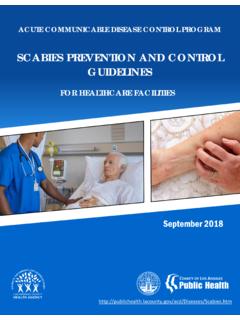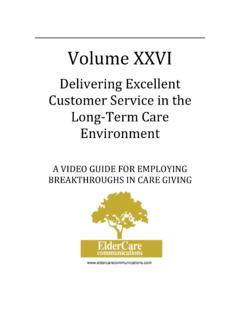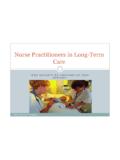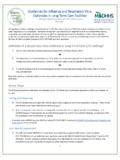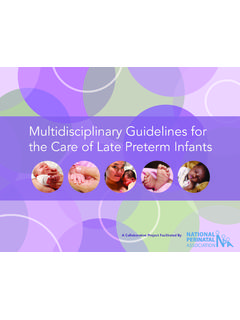Transcription of Design Guidelines for Hospitals - Long term care ...
1 5/24/20111 Margaret Calkins, InstituteRobert N. Mayer, B. & Maurice L. Rothschild FoundationThe experience of the person interacting with our healthcare system can have a significant impact on the outcome of that interaction. Definitions abound but the commonalities are: a reaffirmation of the importance of the therapeutic relationship, a focus on the whole person and lifestyle not just the physical body, a renewed attention to healing, and a willingness to use all appropriate therapeutic approaches, whether they originate in conventional or alternative medicineInstitute of Medicine, 20095/24/20112 Quality-Care ApproachProviding the right care in the right way at the right time. Person-Centered ApproachProviding the care that the person needs, in the manner the person desires, at the time the person wishes.
2 Nothing about me without me. 460 BC Ancient Greek school of Cos, which was interested in the particulars of each patient1950s Client-centered therapy (Rogers)1970s Total-person approach to patient problems in nursing (Neumanand Young); disease-versus patient-centered medical practice (Byrne and long ); term coined by Tom Kitwoodin England1980s Biopsychosocialmodel (Engel)1990s Patient-centered concepts applied to the hospital setting (Gerteis)2000s Institute of Medicine (IOM) includes patient-centered care as 1 of 6 domains of quality Empowerment Choice Voice Healing environments Community Dignity Privacy Improves patient satisfaction Improves clinical outcomes Improves quality and safety Reduces cost of healthcareQUALITY Proprietary Models Polarization byAcuityLevel Multiple Small Advocacy Organizations Diversity of Focus Direct care workforce Patient/elder experience Built environment Family engagementPerson-DirectedCulture ChangeFamily-Centered Self-Directed Patient-Directed Relationship-Based Patient-centered 5/24/20113 Younger IndependentOlderDependentInstitutionalAc ute CarePerson-Centered CareInstitutional Chronic CareNon-Institutional Care We shape our dwellings.
3 And afterwards they shape us (House of Commons-October 28, 1944) Design Guidelines for HospitalsImplementing Person-centered Design in Healthcare: Building Connections2010 Edition5/24/20114 Past 1976 Minimum Requirements1)Maximum capacity shall be 4 patients2)Minimum area:1)100 sq. ft. in a single2)80 sq. ft. per bed in multiple bed rooms3)One lavatory in each patient room, omitted in a single or semi-private, may be shared with other roomsAnd the miracle happens! Single bed room Medical/surgical units Obstetrical units NICU Supported by research Coalition for Health Environments Research Facility Guidelines Institute Center for Health DesignPresent 2010 GuidelinesAppendixIn new construction, single patient rooms should.
4 Accommodate comfortable furniture for family members (one or two) without blocking access of staff members to patients. Patient/Family-Centered Care RoomsAppendix a)Capacity should be a single-bed roomb)250 square feet clear floor areac)30 square feet per family memberd)Homelike atmosphereGuidelines Development Revised every four years 130 person Multidisciplinary committee Public Process everyone is encouraged to participate 2014 edition proposal period open until October 31, 2011 Electronic submission of the decision-maker Time it takes for new standards to be approved Time it takes for a new hospital to be created and deliveredChallenges of the decision-maker We buy new health care facilities all wrong Focused on first cost Very little thought during the planning phase Functional program not a focus of many organizations How do we change our bad habits?
5 Fable hospital as an example More research that gets into the C suite5/24/20115 The 2010 Healthcare Environments Awards Professional Conceptual Winner Patient Room 2020 LTC Policy, Regulations, Codes & Guidelines :Steps in the Right DirectionHistoryOBRA Regulations(Omnibus Budget Reconciliation Act orNursing Home Reform Act of 1987)Federal Standard to improve care:US Code of Federal Regulations (42 CFR Part 483) OBRA Intent Meant to represent minimum accepted standards of care Changed focus of care from input to outcome based Quality of care Quality of life Completing a written comprehensive resident care plan focused on well-being (provision of services & activities to attain or maintain highest practicable physical, mental, and psychosocial well being of resident)5/24/20116 General OBRA requirements.
6 Nursing home responsible for resident safety Medical orders coordinated and reviewed from primary care physician Provide services to enhance resident quality of life to the fullest Maintain resident dignity & respect Conduct initial & follow-upcomprehensiveresident assessment Freedomfrom chemical & physical restraintsResource: General OBRA requirements: Prevent/reduce decline in ADL(activity of daily living) with assistance as required Prevent/reduce development of bed soreswith proper treatment if does occur Appropriate care for residents with urinary incontinence & restore bladder functionif possible Prevent accidents and facility acquired events: falls, medication errors, infection, : General OBRA requirements: Prevent unnecessary weight lossthrough adequate nutrition Maintain sufficient fluidintaketo prevent dehydration Maintain adequate quantity of trained staff Resident Choice: rights to choose activities, schedules, health care, etc.
7 Medication servicesthat meet the individual resident needsphysically and psychologically Maintain accurate, complete, & accessible clinical/health recordsResource: Compliance Residents must be assessed for not only medical conditions, but also for basic self-care activities asindividuals MDS (minimum data set) used to document assessment Compliance for Medicare & Medicaid Reimbursement Ensure compliance through state survey process Penalties are weighed for non-compliance: fines, administrative consultants to run nursing home while deficiencies are remedied, and closure of a nursing homeResource: (short for Federal Tag)Provides Additional Guidance on CMS Regulations F-tags & Person-Centered Care CMS & Pioneer Network: Creating Home in the Nursing Home: A National Symposium on Culture Change & the Physical Setting Requirements 2009: CMS released revisions to 11 interpretive Guidelines Related to person-centered care, needs, and preferencesResource: : Nursing Homes-Issuance of Revisions to Interpretive Guidance Part of Appendix PP, State Operations Manual 5/24/20117 F-172 Visitation (24/7 access) F-175 Married Couples (right to share room) F-241: Dignity (signage, confidentiality, resident access to common areas) F-242.
8 Self-Determination & Participation (Choice over schedules) F-246 Accommodation of Needs (providing adaptations to promote choice: furniture, access to supplies, etc.) F-247 Notice Before Room or Roommate Change (roommate passes, allow grieving time, explain new room, introductions)Resource: F-252 Safe, Clean, Comfortable & Homelike Environment (defines intent of homelike , strive for elimination of institutional practices) F-256 Adequate & Comfortable Lighting (minimum of glare, contrast between surfaces, adequate lighting Design ) F-371 Sanitary Conditions (food procuring & handling) F-461 Resident Rooms (Closet Portion) (residents to reach their own clothing) F-463 Resident Call System (allows wireless call systems)Resource: Living Sustainability Guide & Person-Centered CareResource.
9 Living SustainabilityGuide FourDimensionsResidentOrganizationOperat ionsPhysical SettingMeasured OutcomesContinuousImprovementResidentOrg anizationOperationsPhysicalSettingOutcom esContinuous improvement feedback. (Commissioning and post occupancy)Resource: (Minimum Data Set )& Person-centered CareResource: History of MDS: 1986 & Part of 1987 OBRA 1986 report on quality of care (Katz S, Adams C, Beigel A. Improving the Quality of Care in Nursing Homes. Washington, DC: National Academy Press; 1986.) Functional impairment & co-morbidities not addressed: Either not identified or Attributed to old age or dementia. Report recommended shifting nation s strategy for monitoring & improving NH care Using structured evaluations with systematic and standardized assessments Resident s cognitive, functional, and emotional needsResource: History of MDS: 1986 & Part of 1987 OBRA This information then utilized as basis for development of care plans and interventions.
10 450 item assessment: functional status, mood, and medical conditions of NH residents MDS is part of the longer Resident Assessment Instrument (RAI) That includes Resident Assessment Protocols (RAPs)Resource: MDS implemented October 1, 2010 MDS Updates: Development of a Person-Centered Comprehensive Care Plan Designed to included the resident within the assessment process Increase the resident s voice by including more resident interview items Improve reliability, accuracy, and usefulness of the data Enhance individual care planning & outcome measurementResource: Comparable to MDS : National Trial 81% More clinically relevant 85% Help staff identify problems that might not have been noticed without the MDS 79% items more likely help staff detect resident s status changes 84% Structured interview sections (cognition, mood, customary routine, activities, pain) improved staff knowledge of resident and their health conditionResource: Comparable to MDS : National Trial 89% more accurate report of resident s characteristics 76% items better reflect clinical practice of standards 85%: Questions clearer 76%: Clarified several difficult itemsResource: : Example Section:Customary Routine & Activity Items: Use of Preference Assessment Tool Response Scale5/24/20119 MDS Example Section.

